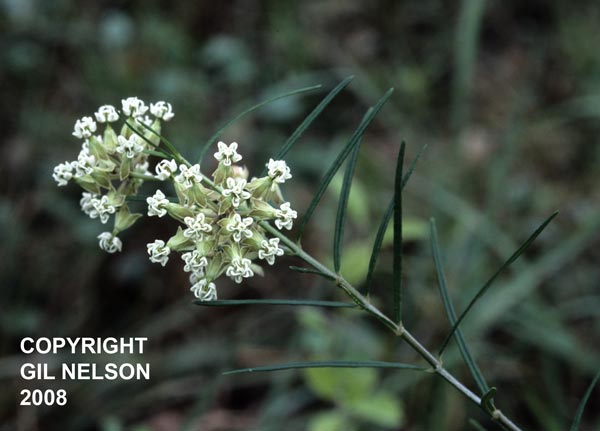Asclepias verticillata
| Asclepias verticillata | |
|---|---|

| |
| photo by Gil Nelson | |
| Scientific classification | |
| Kingdom: | Plantae |
| Division: | Magnoliophyta - Flowering plants |
| Class: | Magnoliopsida - Dicotyledons |
| Order: | Gentianales |
| Family: | Asclepiadaceae |
| Genus: | Asclepias |
| Species: | A. verticillata |
| Binomial name | |
| Asclepias verticillata L. | |

| |
| Natural range of Asclepias verticillata from USDA NRCS Plants Database. | |
Common names: Whorled Milkweed
Contents
Description
Distribution
It is found from Massachusetts, south to Texas, east to Florida, and west to Arizona (Weakley 2015).
Ecology
Habitat
Native upland pine and pine-hardwood communities, loblolly pine plantations (Ultisols), borders of wetland depressions within pine communities, sandhills and sand ridges, (Entisols), open calcareous glades, bluffs along Apalachicola River (FSU Herbarium). It can be found in bluestem prairie (Hover and Bragg 1981). It increases with spring burning (Hover and Bragg 1981). It is a warm-season grass (Hover and Bragg 1981). Can occur in areas with soil disturbance (FSU Herbarium). Thrives in frequently burned areas and flowers within two months of burning in the growing season (Robertson observation). Tolerates full sunlight to partial shade. Tolerates moist to xeric conditions but seems to be limited to sandy or calcareous soil. Found barrens of thin soils of rock outcrops (mafic rocks), also in woodlands and sandhills (Weakley 2015) and in flatwoods (Wunderlin and Hansen 2011).
Phenology
It flowers and fruits from April to September (FSU Herbarium; Weakley 2015). It resprouts and flowers within a few weeks of being burned from early spring through summer, but it also flowers in years when it is not burned up to at least five years following fire, primarily in July and August (KMR[1]).
Seed dispersal
Asclepias verticillatahas seed pods that are vertically oriented and disperse seeds by wind after dehiscence (Instructor).
Seed bank and germination
Fire ecology
Pollination
Use by animals
Diseases and parasites
Conservation and Management
Cultivation and restoration
Photo Gallery
References and notes
Florida State University Robert K. Godfrey Herbarium database. URL: http://herbarium.bio.fsu.edu. Last accessed: June 2014.
Hover, E. I. and T. B. Bragg (1981). "Effect of season of burning and mowing on an eastern Nebraska Stipa-Andropogon prairie." American Midland Naturalist 105: 13-18.
Weakley, Alan S. Flora of the Southern and Mid-Atlantic States: Working Draft of 21 May 2015. University of North Carolina Herbarium (NCU). PDF. 933.
Wunderlin, Richard P. and Bruce F. Hansen. Guide to the Vascular Plants of Florida. Third edition. 2011. University Press of Florida: Gainesville/Tallahassee/Tampa/Boca Raton/Pensacola/Orlando/Miami/Jacksonville/Ft. Myers. 271. Print.